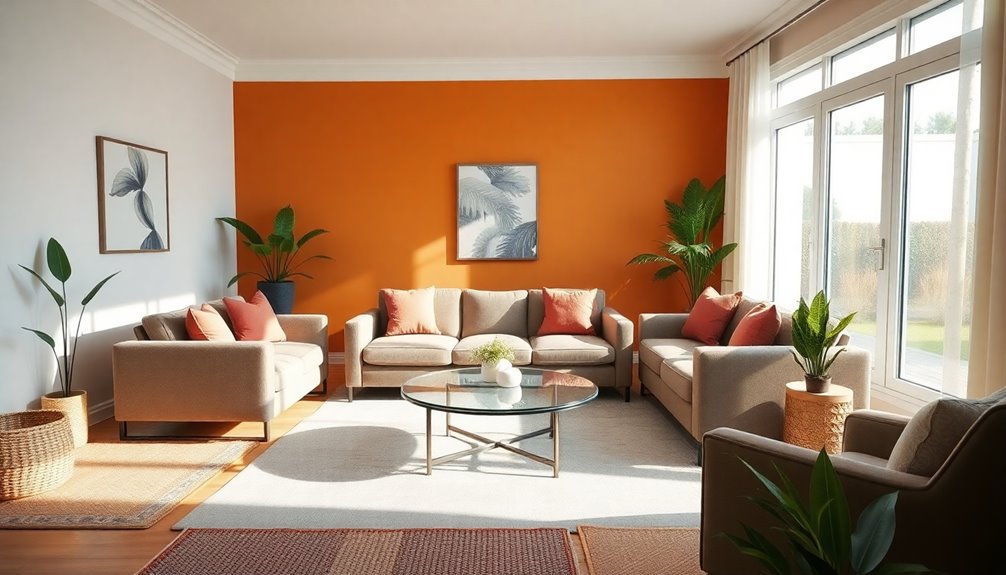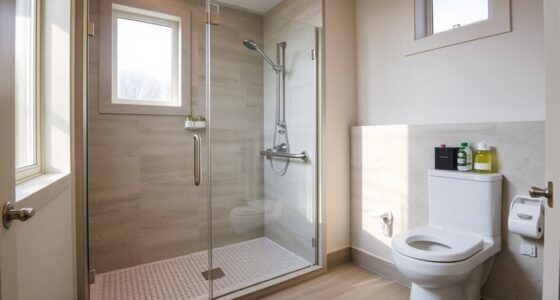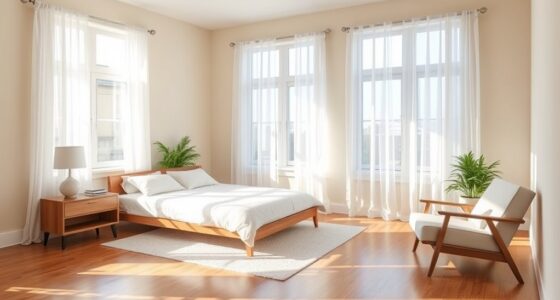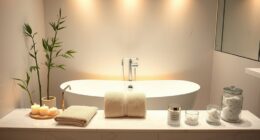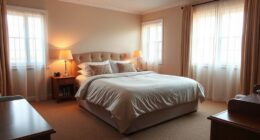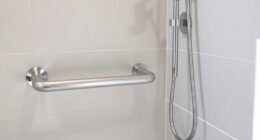Integrating universal design principles into your home decor makes your space more accessible and comfortable for everyone. Focus on creating open layouts with flexible furniture arrangements and guarantee key areas like kitchens and bathrooms cater to various mobility needs. Use contrasting colors for visibility and select inclusive furniture that accommodates different users. Consider smart technology for added convenience and safety, enhancing your home's functionality. There's so much more to explore about creating an inclusive environment.
Key Takeaways
- Create an accessible layout with a minimum turning space of 5 feet in rooms for easy navigation, especially for wheelchair users.
- Use contrasting colors to enhance visibility and define spaces, ensuring safety and clarity for individuals with visual impairments.
- Choose adjustable or modular furniture that accommodates various needs, making spaces flexible and comfortable for all users.
- Incorporate smart home features like motion-sensing lights and remote control thermostats for added convenience and safety.
- Prioritize wider hallways and doorways to facilitate movement, making your home more inclusive for everyone.
Understanding Universal Design Principles
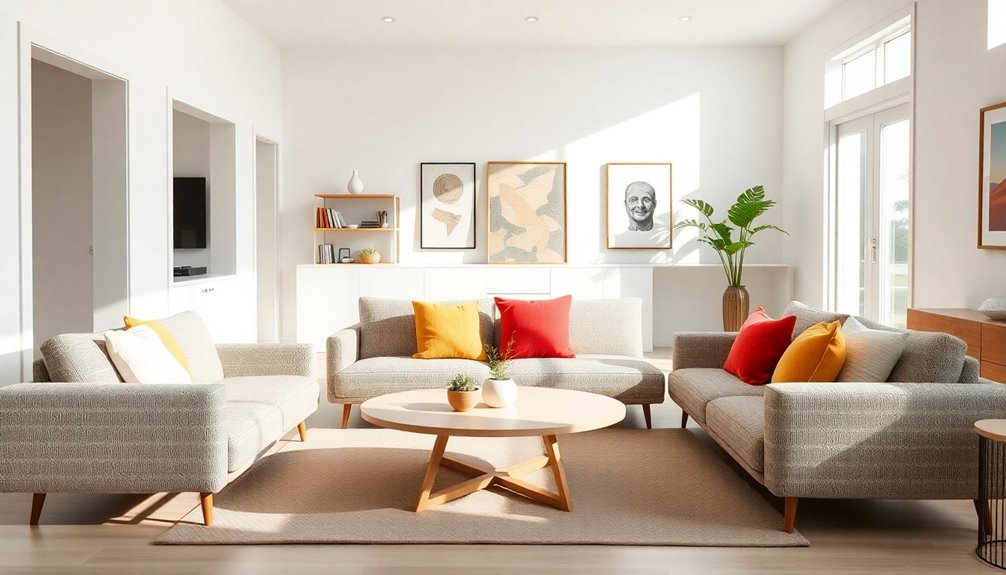
Universal design principles revolve around creating spaces that everyone—regardless of age or ability—can easily navigate and enjoy. These principles focus on making environments accessible and usable for all.
The seven principles of universal design include equitable use, flexibility in use, simple and intuitive use, perceptible information, tolerance for error, low physical effort, and size and space for approach and use.
By understanding these principles, you can enhance safety and comfort in your home, reducing the risk of falls and promoting ease of movement.
As more aging populations, particularly baby boomers, seek to remain in their homes longer, the demand for universal design features is on the rise.
You can seamlessly integrate practical accessibility with aesthetic appeal, proving that style and functionality can coexist.
Key Features of Universal Design in Home Decor

When it comes to universal design in home decor, accessible layout strategies can make a big difference in how you navigate your space.
Choosing adaptive furniture allows for flexibility and comfort, ensuring that your home meets various needs.
Let's explore how these features can enhance both functionality and aesthetics in your living environment.
Accessible Layout Strategies
Creating an accessible home layout involves several key strategies that enhance comfort and mobility for everyone.
Guarantee at least one bedroom and bathroom are on the ground floor, making it easier for those with mobility limitations to navigate.
Maintain a minimum turning space of 5 feet in every room, allowing for easy maneuverability of wheelchairs and other mobility devices.
Expand hallway widths to 3.5 to 4 feet for smoother navigation throughout your home.
Position light switches between 36 to 48 inches from the floor, accommodating both standing and seated users.
Finally, utilize open floor plans and flexible furniture arrangements to create adaptable spaces that can easily adjust to varying needs and preferences, guaranteeing your home remains welcoming for all.
Adaptive Furniture Choices
Adaptive furniture choices play an essential role in making your home more inclusive and functional.
Consider adjustable height tables and desks that cater to various abilities, allowing for both seated and standing work styles. Multi-functional furniture, like sofa beds and storage ottomans, maximizes space while meeting diverse needs.
Incorporate pieces with rounded edges and soft surfaces to reduce injury risks, especially for children and seniors. Look for furniture with easy-to-grip handles and controls, such as pull-out shelves and push-to-open drawers, to enhance accessibility for those with limited dexterity.
Finally, choose lightweight, movable designs to create flexible arrangements that adapt to your changing needs, embodying the core principles of universal design in your home decor.
Enhancing Accessibility Through Thoughtful Layouts
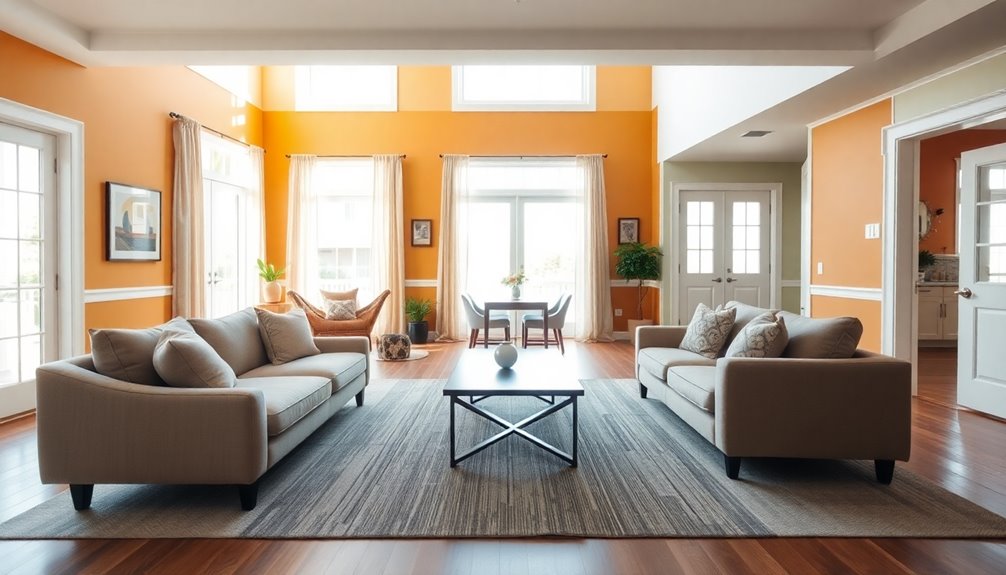
Thoughtful layouts in home design can markedly enhance accessibility for everyone, particularly those with mobility challenges. By incorporating at least one bedroom and bathroom on the ground floor, you guarantee convenience for all residents.
Creating a layout with a 5-foot diameter turning space in every room allows wheelchair users easy maneuverability, promoting comfort. Expanding hallway widths to 3.5 to 4 feet facilitates smoother navigation, especially for those using mobility devices.
Additionally, arranging furniture for easy movement creates flexible spaces that adapt to various needs. Finally, reducing the number of steps and hallways improves overall flow and accessibility, making it easier for everyone to navigate their living spaces.
Embracing these universal design principles fosters an inclusive environment for all.
The Role of Color and Contrast in Universal Design
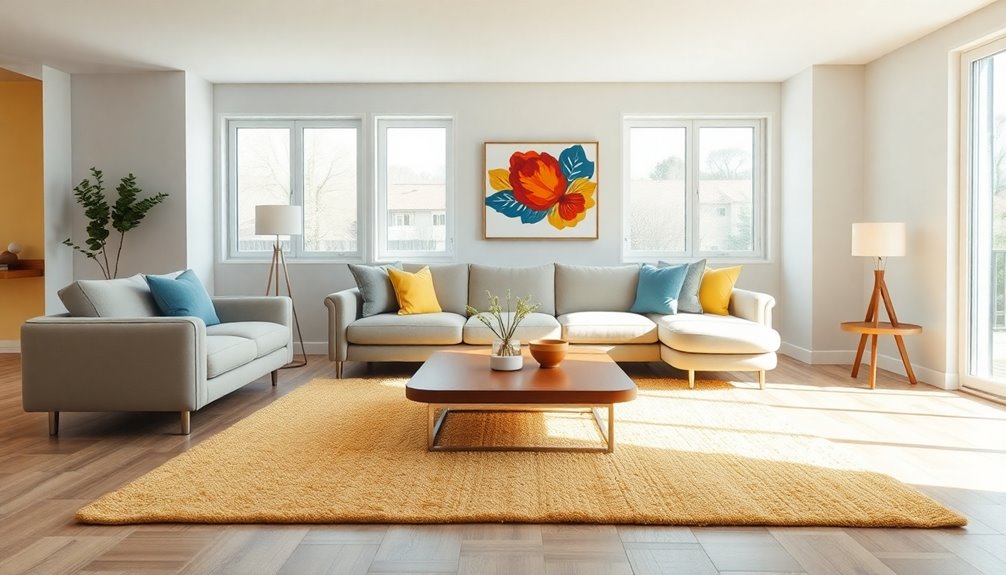
When you choose colors for your home, think about how contrast can enhance visibility, especially for those with visual impairments.
Using distinct color schemes not only defines spaces but also highlights hazards and important features like handrails.
Enhancing Visibility Through Contrast
Creating a space that's visually accessible involves using contrasting colors effectively. By enhancing visibility with strategic color choices, you can define areas and highlight potential hazards like steps or uneven surfaces. Consider using contrasting colors for essential features, such as handrails, to make them easier to locate and use. Air purifiers with HEPA filtration can further improve indoor air quality, contributing to a healthier living environment.
Here's a quick reference table for effective color contrasts:
| Element | Suggested Contrasting Color |
|---|---|
| Walls | Light Gray and Dark Blue |
| Floors | Beige and Dark Brown |
| Handrails | Bright Yellow and Black |
| Furniture | White and Charcoal |
| Steps | Light Yellow and Dark Gray |
When you minimize patterns and focus on solid colors, you create clarity, benefiting everyone, especially those with visual processing challenges.
Color Schemes for Accessibility
Color schemes play an important role in enhancing accessibility within home decor. By utilizing contrasting colors between walls, floors, and furniture, you can greatly improve visibility for individuals with visual impairments, making navigation easier and safer.
Strategically applying color to highlight essential features, like handrails and steps, helps prevent accidents and guarantees these elements are easily identifiable. When selecting color schemes for accessibility, consider color-blind accessibility to create an inclusive environment where everyone can perceive critical information clearly.
Additionally, minimizing busy patterns and opting for solid colors simplifies visual processing, reducing distractions. Implementing neutral colors with simple patterns can further enhance the visibility of items placed on surfaces, accommodating users with varying levels of visual ability. Furthermore, creating a sense of calm through organized environments can significantly contribute to overall emotional well-being in your living spaces.
Selecting Inclusive Furniture and Fixtures
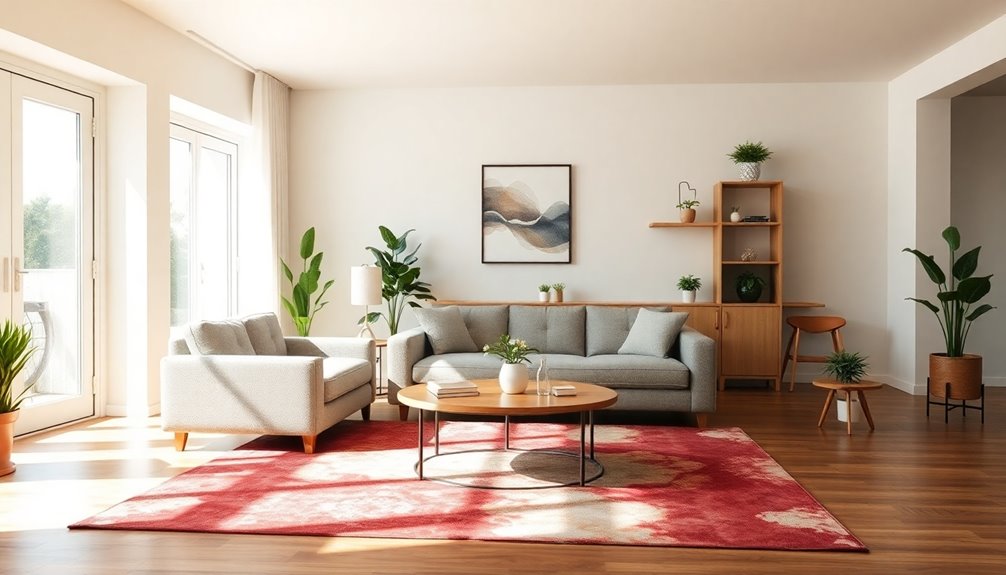
Inclusive furniture and fixtures are essential for creating a welcoming and functional home environment. When selecting pieces, prioritize furniture with adjustable heights or modular designs to enhance accessibility for everyone.
Look for seating that features armrests and firm cushions, making transfers easier for those with mobility challenges. Choose items with rounded edges and soft corners to minimize injury risks, especially in homes with children or individuals who've reduced mobility.
Incorporate storage solutions with pull-out shelves and full-extension glides for easy access. Finally, opt for fixtures that use lever-style handles and touchless technology, as they're easier to operate for individuals with limited grip strength or dexterity.
This thoughtful selection promotes comfort and usability in your space.
Incorporating Smart Technology for Better Usability
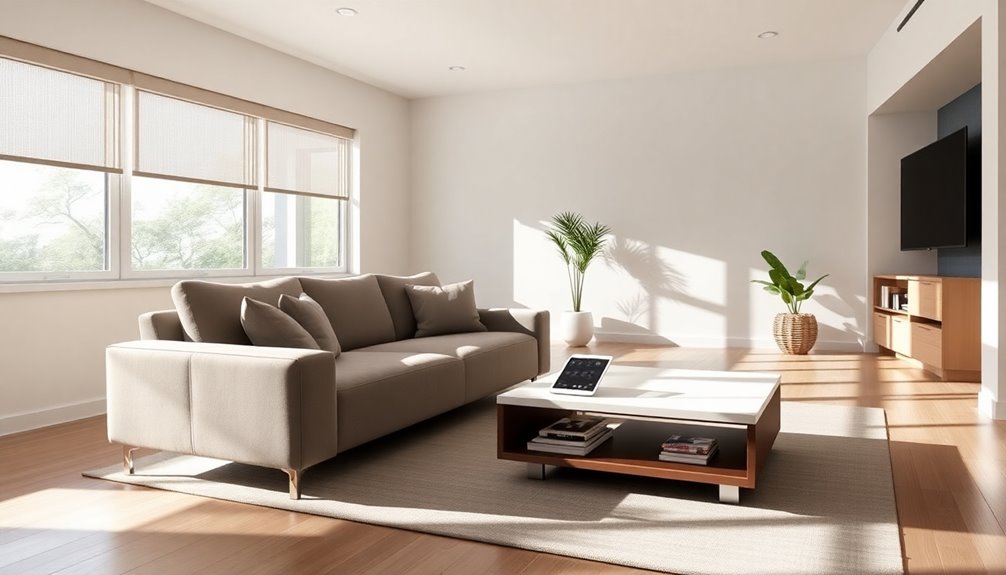
As you embrace smart technology in your home, you'll find that it considerably enhances usability for everyone, especially those with mobility challenges.
Universal design principles come to life through smart home technology, allowing you to control appliances, lights, and HVAC systems from your smartphone or with voice commands. This accessibility is a game-changer, enabling easy management of your environment without physical effort.
Features like motion-sensing lights automatically illuminate your path at night, enhancing safety. Smart locks and thermostats allow you to adjust settings remotely, creating a personalized living space. Additionally, the integration of AI technology in smart home devices can further improve security and convenience, ensuring a safe and efficient living environment.
Real-Life Examples of Universal Design in Action
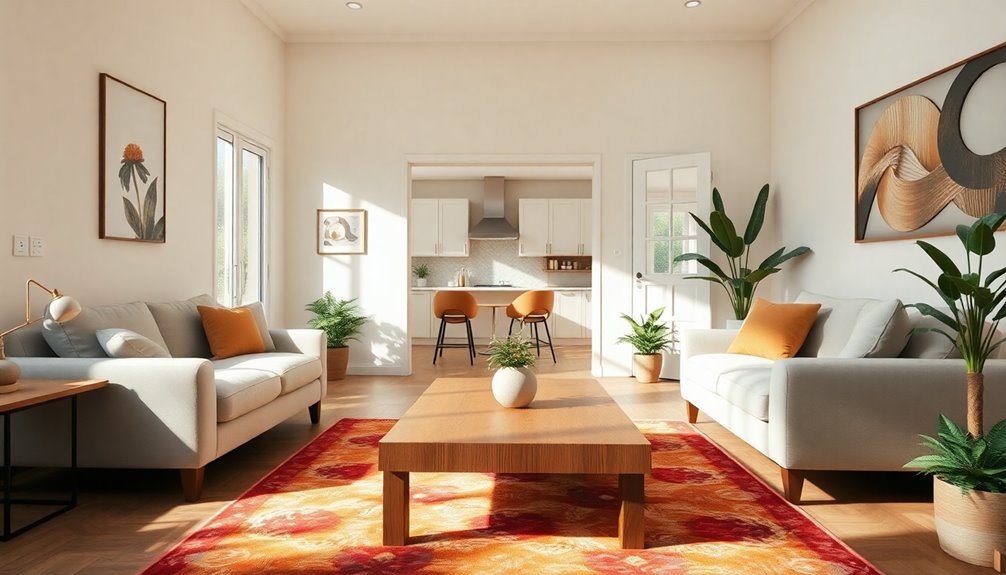
While you mightn't realize it, universal design principles are already enhancing countless homes, making them more functional for everyone.
For instance, lever door handles replace traditional knobs, ensuring easier access for users of all abilities. You may notice wider hallways and doorways, which promote movement for individuals using mobility devices.
In an accessible bathroom, roll-in showers and grab bars enhance safety and accessibility, catering to varying mobility needs. Additionally, the use of non-slip flooring helps prevent accidents, allowing individuals to navigate the space with confidence. For those seeking to improve their facilities, installing grab bars safely is crucial, as it ensures maximum support without compromising the structure of the bathroom. These thoughtful design elements collectively create a welcoming environment for everyone, regardless of their physical abilities.
Accessible kitchens often feature adjustable countertops, allowing for equitable use by both seated and standing users.
Additionally, smart home technology empowers you to control lighting and appliances remotely, benefiting those with physical limitations. Smart home devices can also integrate with appliances to enhance functionality and ease of use for everyone.
These real-life examples demonstrate how universal design creates inclusive spaces for all.
Frequently Asked Questions
How Can Universal Design Be Integrated Into Home Design?
You can integrate universal design into your home by focusing on accessibility and flexibility.
Start with wider doorways to accommodate mobility devices, and consider adjustable countertops for comfort.
Replace traditional knobs with lever handles, making it easier for those with limited hand strength.
Use contrasting colors to enhance visibility, and design open spaces with movable furniture to cater to diverse needs.
This approach guarantees your home is welcoming and functional for everyone.
How Do You Incorporate Universal Design Into Your Designs?
To incorporate universal design into your designs, start by choosing lever-style handles instead of knobs for easy access.
Position light switches between 36 to 48 inches from the floor for convenience.
Use contrasting colors to enhance visibility and guarantee safe navigation.
Create open floor plans with ample turning space for mobility.
Opt for multifunctional furniture that adapts to various needs, allowing everyone to enjoy your space comfortably and independently.
What Is an Example of a Universal Design in Everyday Life?
Did you know that around 15% of the world's population lives with some form of disability?
One excellent example of universal design in everyday life is automatic doors. They enhance accessibility for everyone, especially for those using mobility aids like wheelchairs or walkers.
These doors allow you to enter and exit buildings without needing to struggle with heavy handles or knobs, making everyday tasks easier and more convenient for all.
Which of the Following Is an Example of Universal Design in a Home?
When you think about universal design in a home, consider features that enhance accessibility for everyone.
For example, installing lever-style door handles makes it easier for individuals with limited hand strength to open doors. You might also notice wider doorways, which accommodate wheelchair users.
Additionally, grab bars in bathrooms and adjustable countertops in kitchens guarantee safety and comfort for all ages and abilities, promoting a functional living environment that everyone can enjoy.
Conclusion
By embracing universal design principles in your home decor, you create a welcoming space for everyone. Did you know that nearly 1 in 5 people in the U.S. live with a disability? With thoughtful layouts, inclusive furniture, and smart technology, you can enhance accessibility while ensuring your home remains stylish. Remember, designing for all doesn't just benefit those with disabilities; it fosters a more functional and enjoyable environment for everyone who enters your home.
